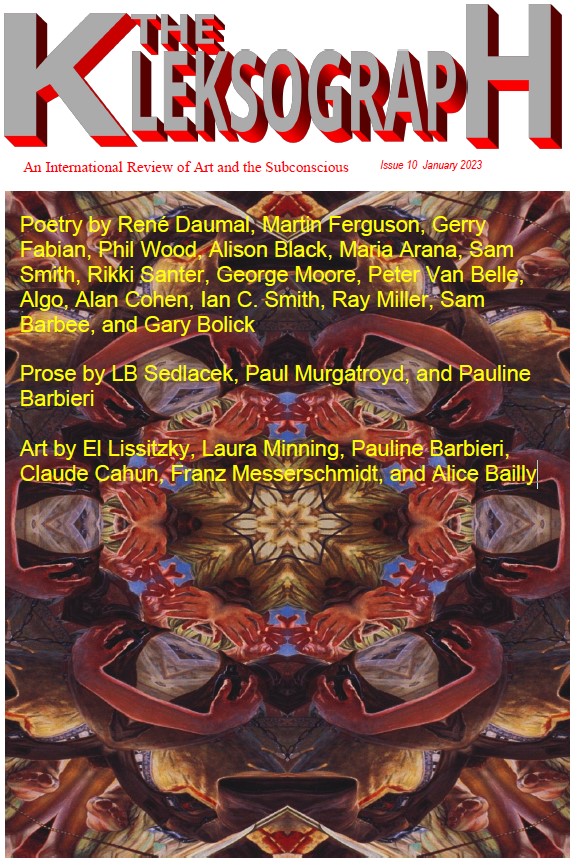The Kleksograph
Website
 From the Editor
From the Editor
An international Review of arts and the subconscious. Surely every work of art is informed by the subconscious? True, but most artists would contend that their work is mainly the result of conscious, rational decisions. Some writers though, draw their ideas from dreams. Franz Kafka, for example. The Klecksograph seeks to explore and celebrate art where the membrane between it and the subconscious is at its thinnest. Consequently the works in this magazine can’t be termed realistic. At the same time, however, it’s not the intention to publish works of magical realism in the conventional sense: where a conscious effort is made to subvert the expectations of realist fiction. Yet magical realist or surrealist writing or visual art isn’t automatically excluded. The magazine is also meant to embody something akin to Rabindranath Tagore’s concept of Vishwa Sahitya, a universal spirit manifesting itself through the arts. As its focus is the subconscious , this would also highlight intercultural subconscious themes and images. You may wonder why the magazine is in English. Many may see it as the language of the colonizer and the imperialist, but so was Latin, which helped to spread Greek philosophy and remained an international language long after the Roman Empire had fallen. Klecksography In 1857 Justinus Kerner started collecting his Kleksographien (Klecks is the German word for blot) and writing short poems describing what he saw in them. The book was posthumously printed in 1890. In 1896 a book was published in the USA called Gobolinks or Shadow-Pictures for Young and Old. This had the same set-up as Kerner’s book: ink-blots with added poems. The phenomenon used in these books is called pareidolia, where a person interprets random marks as recognizable patterns. (Both books are available at Internet Archive). Psychiatrists, among them Alfred Binet and Hermann Rorschach suggested such inkblots could be used to study the subconscious of their subjects. Could the klecksography also serve as a metaphor for life? Both are things we try to make sense of. Our subconscious does this all the time, but can do little to affect it. Yet through our creative works our subconscious expresses these interpretations with beautiful, moving, or terrifying results. Is the reader then like a patient in front of a Rorschach or TAT? TATs (Thematic Apperception Tests) are a set of ambiguous pictures the subject has to make a story about.
Submissions
Reading periods are as follows: September 1 to November 30 for the January issue January 1 to March 30 for the May issue May 1 to July 31 for the September issue If your submission is accepted you will receive notification during the reading period. Some individual feedback on submissions may be given, depending on the work load. If you do not receive any notification by the end of the reading period, you can assume your submission has been rejected. Submissions sent in during the months December, April, and August will not be read. Please read the manifesto under ABOUT or check out the selection under Past Masters & Masterpieces before submitting. Include a short bio in your e-mail. You may submit up to five poems, a single story, essay, article, or interview per issue, or four pieces of visual art. Previously published works are okay, as long as the previous publication was more than a year ago. If your work is published in the magazine, you may submit work for the next issue during the following reading period. Poetry & prose can be pasted in the body of the e-mail or attached as a separate Word-document (or .txt, .rtf, etc.). Prose submissions must include a word count and must not exceed 2000 words. Put your name, the medium, and the title in the subject line, like this: Julio Cortazar – fiction – Circe All submissions must be in English (AmE, BrE or other, but be consistent). Translations into English are also acceptable. Simultaneous submissions are acceptable, provided you notify us immediately of acceptance elsewhere.
Information
Editors Name Peter Van Belle
Print publication? No
Circulation 200
Do you take online submissions? Yes
Submission Guidelines URL https://www.kleksograph.be/submit-to-the-klecksograph-magazine
Approx. Response Time? 2 weeks
How often do you publish? 3 times per year
Year Founded? 2019
Do you pay? no
Contact
Twitter
Mailing Address:
Email kleksograph@gmail.com
Facebook The Kleksograph page